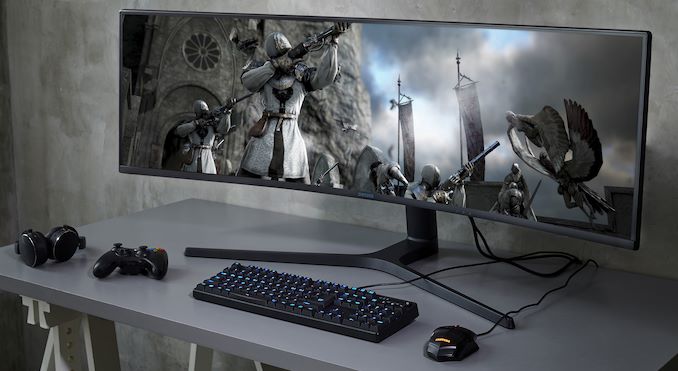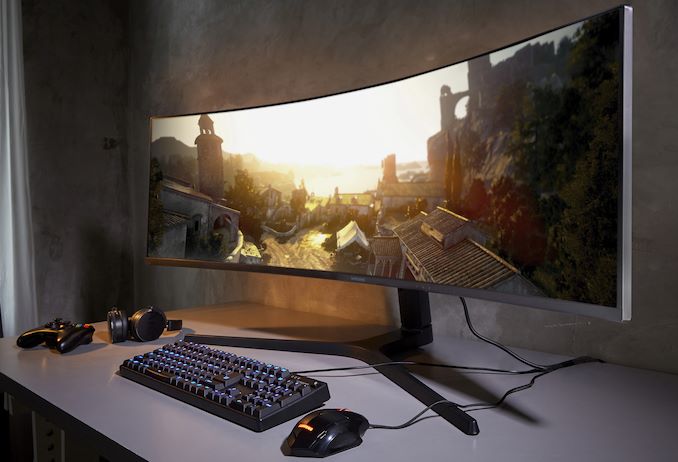Samsung Announces CRG9: A 49-Inch Curved 5K 120 Hz FreeSync 2 Monitor
by Anton Shilov on January 3, 2019 7:30 PM EST
Samsung has announced its second-generation 49-inch curved display supporting AMD’s FreeSync 2 technology. The new CRG9 monitor features a considerably higher resolution and brightness than the first-gen C49HG90 LCD introduced in mid-2017.
Samsung was the first display maker to launch a family of AMD FreeSync 2-supporting monitors in mid-2017 with a 49-inch curved C49HG90 LCD being its flagship offering. Without any doubts, the monitor was an impressive piece of hardware, yet at $1,499 it was not exactly perfect with its 3840×1080 resolution and a 600 nits brightness. Since then, a number of display suppliers have introduced their FreeSync 2-supporting offerings yet neither of them was actually as impressive as Samsung’s FS2 products. In the meantime, Samsung has been working on its second-gen FreeSync 2-enabled flagship monitor.
The new Samsung CRG9 ultra-wide display is based on the company’s new curved VA panel featuring a so-called 'dual QHD' resolution (5120×1440), a 1000 nits peak brightness, 178º/178º vertical/horizontal viewing angles, a 4 ms response time, and a 120 Hz refresh rate. In a bid to increase resolution of its flagship gaming display from 3840×1080 and brightness from 600 nits, Samsung had to lower refresh rate from 144 Hz to 120 Hz, which seems like a fair tradeoff.
Just like in case of the previous-gen 49-incher, the new CRG9 display has a LED backlighting enhanced with quantum dots that enable support for the DCI-P3 color space (as well as larger-than-sRGB gamut) and the HDR-focused AMD’s FreeSync 2. Speaking of HDR, the monitor fully supports HDR10 (but Samsung says nothing about Dolby Vision) and bearing in mind that we are dealing with a panel featuring a peak brightness of 1000 nits, it will likely carry VESA’s DisplayHDR 1000 badge.
Connectivity wise, the new monitor supports two DisplayPorts, one HDMI input, a USB 3.0 hub, and a headphone connector.
| General Specs of Samsung's 2nd Gen 49-Inch LCD with AMD FreeSync 2 | ||
| CRG9 | C49HG90 |
|
| Panel | 49" VA | 49" VA |
| Native Resolution | 5120 × 1440 | 3840 × 1080 |
| Maximum Refresh Rate | 120 Hz | 144 Hz |
| Response Time | 4 ms | 1 ms MPRT |
| Brightness | 1000 cd/m² | 600 cd/m² |
| Contrast | ? | 3000:1 (typical) 2400:1 (minimal) |
| Backlighting | LED w/Quantum Dots with local dimming | LED w/Quantum Dots |
| Viewing Angles | 178°/178° horizontal/vertical (?) | 178°/178° horizontal/vertical |
| Curvature | 1800R | |
| Aspect Ratio | 32:9 (3.56:1) | |
| Color Gamut | DCI-P3 | 95% DCI-P3 |
| Dynamic Refresh Rate Tech | AMD FreeSync 2 | |
| Pixel Pitch | 0.234 mm² | 0.312 mm² |
| Pixel Density | 108.54 PPI | 81.41 PPI |
| Inputs | 2 × DisplayPort 1 × HDMI |
1 × DisplayPort 1 × mDP 2 × HDMI |
| Audio | 3.5 mm input and output | |
| USB Hub | USB 3.0 connectors | 2 × USB 3.0 Type-A connectors 1 × USB 3.0 Type-B input |
| MSRP | ? | $1499 |
Samsung did not disclose when it intends to start sales of the CRG9 monitor and how high its price is going to be. Based on unofficial information, the panel for the CRG9 display was expected to enter mass production in November 2018. If this is the case, then the commercial launch of the LCD is rather close. Samsung yet has to announce all the specs of its CRG9 monitor, so expect them to be disclosed around the time when it comes to market.
Related Reading:
- Samsung Announces First Freesync 2 Monitors: CHG70 & CHG90 - Quantum Dots, Up to 49”, 144 Hz, DCI-P3
- Dell U4919DW Curved Display Unveiled: 49 Inches, 5120x1440
- MSI Optix MAG491C Hands-On: A 49-Inch 32:9 LCD with FreeSync
- ASUS Launches VG49V: An Ultrawide Curved 32:9 49-Inch FreeSync LCD
- LG to Demo UltraWide 38-Inch 144Hz Gaming & 49-Inch Workstation Displays at CES
- Philips Preps 499P9H Curved 49-Inch 5K Display with USB-C Docking & Webcam
Source: Samsung












33 Comments
View All Comments
lilkwarrior - Friday, January 4, 2019 - link
How is Nvidia fleecing buyers if it's better & held to a far higher standard, particularly G-SYNC HDR vs Freesync 2?DrKlahn - Friday, January 4, 2019 - link
Because any difference is marginal at best in any blind test I've seen. Also Nvidia can support both it's proprietary interface and the free standard at the same time on the same hardware. It's customers can decide at that point whether it's worth it. Thus fleecing it's customers by forcing them to buy their premium standard.Hubb1e - Friday, January 4, 2019 - link
Another reason to support AMD on this. They've historically been very open with their standards going back as far as I can remember.nevcairiel - Friday, January 4, 2019 - link
The sad part is that there is no AMD GPU that could even properly drive a 5K 120Hz screen. No AMD GPU has enough power to render any recent game anywhere close to making use of that screen.yeeeeman - Friday, January 4, 2019 - link
Neither nvidia really.piroroadkill - Friday, January 4, 2019 - link
It does contain fewer pixels than an actual 4K screen, though, by 921,600 pixels. So a 2080 Ti that's already over 60 FPS at 4K could drive this lower resolution screen at a higher frame rate.lilkwarrior - Friday, January 4, 2019 - link
That's patently false; Nvidia cards can definitely & easily support monitors of these ratios.Even true 4K ultrawides (LG's 5K2K monitor) are best ran w/ Nvidia GPUs at rates that max what the monitors can do today for pro & gaming uses.
AMD has not prioritized accommodating such monitor arrangements at & beyond 4K with their mainstream GPUs binned from their workstation cards with performance in mind compared to Nvidia that has cards that unapologetically do; that said an AMD card should have no problem running this monitor that is ultimately a 1440p monitor with a common ultra-wide aspect ratio utilized.
godrilla - Saturday, January 26, 2019 - link
On paper two vega 7s in crossfire should be able to handle this just fine and be cheaper and more powerful that a titan rtx and and msi lightning z 2080ti!imaheadcase - Friday, January 4, 2019 - link
Yah because replacing videocard based on a monitor is totally worth it...said no one ever.haukionkannel - Friday, January 4, 2019 - link
Good monitor cost 1200-2000$ and last 8-15 years.Good graphic card cost 250-2500$ and last 2 to 5 years...
Definitely you buy GPU more often, and keep the monitor, so monitor affects what GPU you will buy.